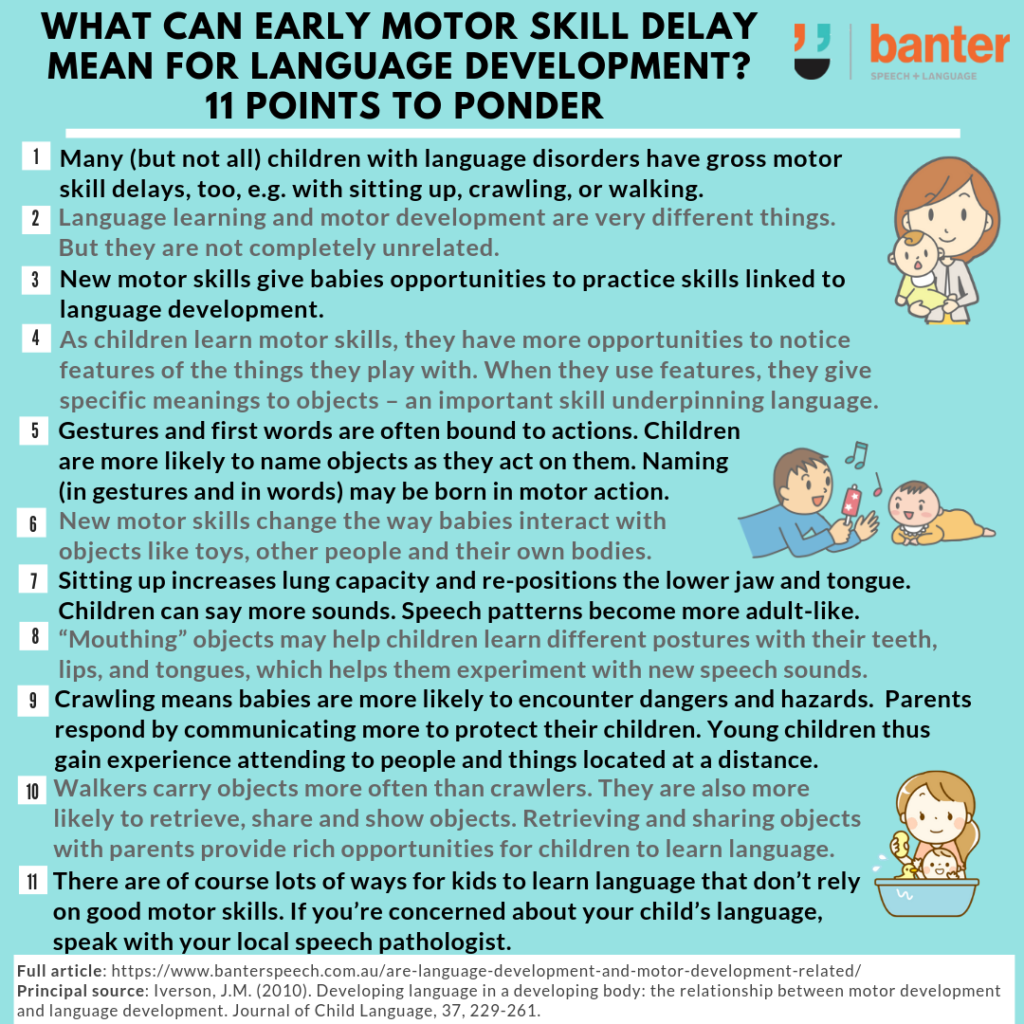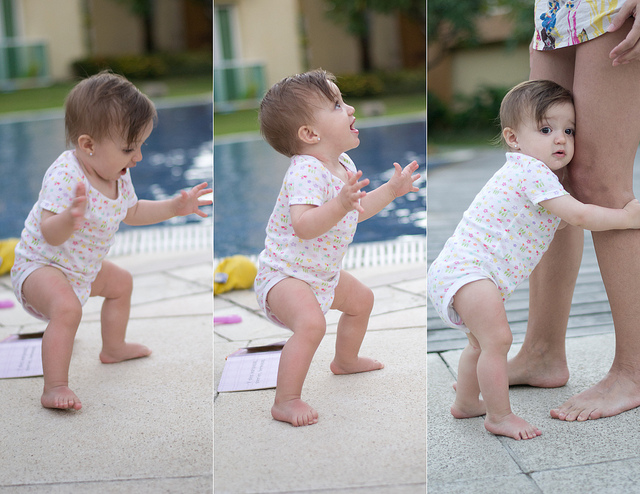Are language development and motor development related?
Why do speech pathologists ask questions about motor development when assessing children for language disorders?
Many children with language disorders also have a history of motor difficulties, e.g. delays in sitting up independently, crawling and/or walking (Hill, 2001). But academic researchers in language development often exclude children with motor delays from their studies of children with language disorders and even their definitions of specific language disorder (e.g. Leonard, 2000).
Like most speech pathologists in practice, I ask parents and carers about their child’s developmental milestones as part of a language assessment. Among other things, I want to know when their child first sat up, crawled and walked.
Why?
1. Motor development does not cause language to emerge
In the 1920s-1940s, a group of researchers called the “maturationists” thought that motor and language skills developed in parallel and that language emerged as motor skills matured (e.g. Gessell, 1929). In the 1960s, this view was largely discredited, with researchers demonstrating that language learning is fundamentally different from motor development and that the onset of language is not simply a consequence of improved motor control (e.g Lenneberg, 1967).
2. Language and motor development are not completely unrelated
More recent studies have suggested that co-occurring motor and language difficulties may have a common underlying genetic basis, with the genes that put a child at risk for communicative impairment also affecting motor development (e.g. Bishop, 2002). This view is supported by research on children at risk for autism spectrum disorder and dyslexia, for whom attainment of early motor milestones like sitting up often lags behind that of typically developing children (e.g. Iverson & Wozniak, 2007, Viholainen et al., 2006).
3. New motor skills can contribute to language development
In the last decade, researchers like Dr Jana Iverson have undertaken research and reinterpreted older studies to argue persuasively that new motor skills can play an important role language development:
A. New motor skills give babies more opportunities to practice skills that are relevant to language development. For example:
- Rhythmic hand and arm movements allow babies to practice rhythmically organised, tightly timed actions of the sort required for babbling. Studies show that these hand and arm movements emerge usually two or three weeks prior to “reduplicated babble” (e.g. mamama, bababa, dadadada) (e.g. Oller & Eilers, 1988).
- Before children start to talk, they tend to take things apart (e.g. pulling nesting cups apart). With the advent of first words, putting things together becomes more frequent. Children also begin to put objects together in different ways (e.g. putting a bead inside a nesting cup). As a child’s vocabulary grows, children tend to make use of specific features of objects (e.g. putting a bead on a string, rather than putting it in a nesting cup). This may reflect advances in cognition that underpins both motor and language advances. But it may also suggest that, as a child develops motor skills, children are presented with more opportunities to notice specific features of the things they play with, e.g. that a string fits into the hole in a bead. As they make use of these features, they give specific meanings to objects – an important skill underpinning language.
- First words are often tightly bound to action. Children are highly likely to name objects as they act on them (e.g. Rodgon et al, 1977). Children’s early words tend to refer to small, easily manipulated objects (e.g. Bates et al, 1979). Between 9 months and 12 months of age, children start to use “recognitory gestures” (e.g. putting a toy phone receiver to his/her ear, or putting an empty cup to his/her lips) and first words at around the same time. This suggests that naming (in gestures and in words) may be born in motor action.
B. New motor skills change the way babies interact with objects like toys, other people and their own bodies in ways that are relevant to language development. For example:
- when a child is able to sit up on her own, she discovers new possibilities for vocal production. She can make more sounds because sitting up increases lung capacity, and repositions the main “articulators” particularly the lower jaw and tongue, which are both relevant to consonant-vowel combinations (e.g. MacNeilage & Davis, 2000). Speech patterns thus become more complex; and more like adult speech, e.g. more word-like utterances and several utterances within a single breathe group (e.g. Tingling, 1981).
- between 6 and 9 months of age, children tend to explore objects by putting them in their mouths. This period coincides with when children start producing consonants (which require a degree of vocal tract closure). “Mouthing” objects may thus help children to learn different postures with their teeth, lips, tongue relevant to producing new speech sounds (Ragan & Iverson, 2007).
- when a child starts to crawl, they are more likely to encounter danger (e.g. things they can swallow or fall down/off). Parents respond to this by communicating more – often loudly and with feeling – to try to protect their child. Children thus gain experience attending to people and things located at a distance, e.g. by turning to look at a parent as the parent gestures toward the stairs, then looking at the stairs and back at the parent (e.g. Campos et al, 2000).
- Studies show that, at 13 months of age, walkers carry objects more frequently that crawlers. They are also more likely to share objects by moving to their mothers and holding the object out for inspection (Karasik et al al, 2011). Walking provides walkers with more opportunity than crawling to access things that are far away, to use their hands to carry objects, and to see and locate objects and people in their surroundings. Infants are more likely to learn words when their attention is already focused on what they are ‘naming’ (Tomasello & Farrar, 1986). Retrieving and sharing objects with parents may thus provide rich opportunities for a walking child to learn language.
4. Motor skills are not essential for language development
None of the examples above mean that you need good motor skills to develop good language. Slow motor development doesn’t mean that language development will also be slow. There are lots of ways for children to learn language that don’t rely on motor skills.
Clinical bottom line
The relationship between motor development and language development is complex.
Motor development doesn’t cause language to emerge. But motor skills are one of several sets of abilities that are involved in language development. While motor skills normally play a role in language development, they are not necessary. If a child’s motor skills are delayed, they can still learn language.
New motor skills, such as sitting upright, crawling and walking, can provide lots of opportunities for a child to practice and refine skills that are important for language development. A speech pathologist who is up to speed on the research will view delayed motor milestones as a risk factor for language delay, in part because it may mean the child has had fewer opportunities to practice and refine some of the skills relevant for language development.

Principal source: Iverson, J.M. (2010). Developing language in a developing body: the relationship between motor development and language development. Journal of Child Language, 37, 229-261.
Image: http://bit.ly/1THvfM0

Hi there, I’m David Kinnane.
Principal Speech Pathologist, Banter Speech & Language
Our talented team of certified practising speech pathologists provide unhurried, personalised and evidence-based speech pathology care to children and adults in the Inner West of Sydney and beyond, both in our clinic and via telehealth.








